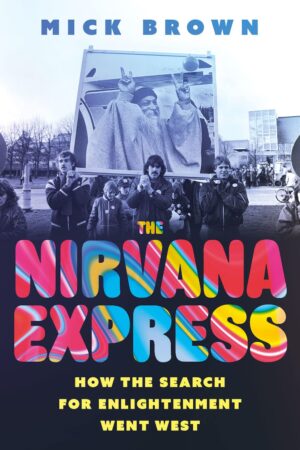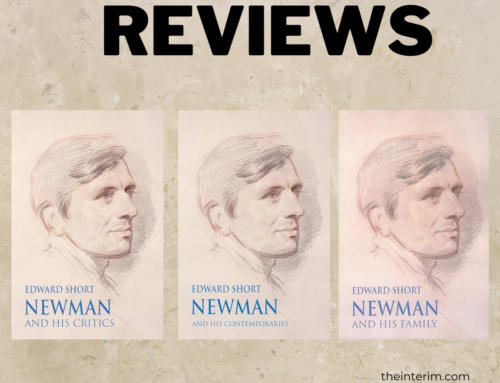Rick McGinnis:

Interim writer, Rick McGinnis, Amusements
The idea of a “God-shaped hole” that came into existence roughly during the Enlightenment and grew with the retreat of religion is mistakenly attributed to the French philosopher Blaise Pascal. The truth is that nobody really knows where the phrase came from, but it has taken on a life of its own, becoming a “meme” probably before anyone really understood what that really was.
And then there’s the assertion that “When men choose not to believe in God, they do not thereafter believe in nothing, they then become capable of believing in anything,” which is attributed to G.K. Chesterton but actually comes from the far more obscure Belgian writer Émile Leon Cammaerts and his study of Chesterton, The Laughing Prophet.
Putting aside the pedigrees of these apparently resonant ideas, we have to acknowledge that they help explain what’s been in plain sight for a couple of centuries, which is that a post-Christian world is not necessarily a more atheist one. Even hardcore atheists (let’s call them fundamentalists or evangelicals) like to assume they proudly believe in nothing, which they glorify by calling it reason or science, while preparing the ground for crusades against non-believers in their non-belief.
Some people opt for a more primal religion substitute, rewind back to a prehistoric world of their imagination and make the earth and the elements their deity; they call it environmentalism and preach that angering the Earth Mother will lead to Apocalypse and the End Times. Others invest their rootless faith in politics and parties, or in nationalism and the mysterious kinship of blood, race, and place.
The most desperate focus their need to believe in celebrities, or hobbies, or a constantly evolving menu of therapies, physical and mental, in pursuit of “wellness.” One suspects that all of them are motivated by a secret envy of established churches, and long for the day their faith achieves tax-exempt status. After all, if Scientology could earn it, why not hot yoga?
I n his book The Nirvana Express: How the Search for Enlightenment Went West, British writer Mick Brown traces roughly a century and a half of westerners seeking to fill their God-shaped holes with the wisdom of the East – more specifically the spiritualism of the Indian subcontinent and its gurus, pandits, yogis, sages, and swamis.
n his book The Nirvana Express: How the Search for Enlightenment Went West, British writer Mick Brown traces roughly a century and a half of westerners seeking to fill their God-shaped holes with the wisdom of the East – more specifically the spiritualism of the Indian subcontinent and its gurus, pandits, yogis, sages, and swamis.
Brown writes that, for spiritual seekers since the Victorian era, “the figure of the guru held out the promise of a personal path to God which conventional religion had patently failed do provide, in an age when science seemed to be pushing God and mystery further to the margins. Eastern mysticism appeared to offer a deeper, richer explanation for human existence – a promise of realising the divinity within that the materialistic view of the world, which argued that man was simply a collection of ‘selfish genes’, did not provide.”
Brown limits his focus to the spiritual practice of South Asia, and to the English-speaking seekers who created a path of pilgrimage between India and Britain and then America. He notes that the Victorian English men and women who pioneered this route “had a particularly conflicted view of the religious beliefs and practices of the Indian subcontinent, compounded of fascination, admiration, bemusement and suspicion.” This was an inevitable condition of colonialism, but it would evolve – albeit retaining its mistaken and sometimes condescending assumptions and cherished myths about spiritual and cultural realities east of the Indus River and south of the Himalayas.
His book is about “truth seekers and dreamers, scholars and idealists, the poets, occultists, hippies and earnest enquirers into the nature of self and soul.”Brown writes, “For some this pursuit would end in disappointment and disillusionment, for others in madness, and for a very few, perhaps, in the attainment of that most elusive holy grail of enlightenment – although who other than the truly enlightened can tell what enlightenment truly is?”
The story begins with Victorian spiritual adventurers hungry for whatever they thought was either withheld or absent in high church Anglicanism, often misreading the history and practice of the holy men and ascetics they encountered or exaggerating their exploits in the interest of celebrating themselves and telling a better story.
The cast of gurus is even more varied – names like Swami Vivekananda and Swami Ramakrishna, Meher Baba, Ramana Maharshi, Madame Blavatsky and Jiddu Krishnamurti. The last is particularly interesting; Krishnamurti was hand-picked by Russian Helena Blavatsky’s Theosophist movement as a child and groomed to be its leader, but he broke with the movement and positioned himself as an independent religious philosopher.
During a long, unchurched period of my life I was briefly attracted to Krishnamurti’s writings, but like so much of the ardently spiritual, putatively mystical literature produced by the sages and seekers Brown writes about, it never seemed to rise above descriptions of what an enlightened mind should look like. A few tantalizing ideas would appear and reappear, recycling themselves into slogans, while whole books moved in ever-smaller rhetorical circles. It was hard to avoid the conclusion that there was, as they say, no there there.
The story is full of eccentric Englishmen who throw off their suits for robes and reinvent themselves as gurus. It’s also full of energetic women, many of them wealthy, who attach themselves to yogis with unseemly ardency. The inner circles around many of these gurus resemble cults, shot through with emotional co-dependency.
The gurus in the first part of the last century attracted a kind of woman who had come to him after investing themselves in suffragism, atheism, Fabianism, vegetarianism, and Socialism. They were often wealthy women whose capabilities were either underestimated by society or overestimated by themselves.
Meher Baba, in particular, believed that enlightenment was wasted on the poor and cultivated his followers among the wealthy in Britain and America, and particularly California, which Brown describes as “the state of boomers and boosters, lured by the promise of new life and new freedoms – a utopia that offered fertile ground for religious proselytizers, cranks, self-styled prophets, crackpots and frauds of every denomination and none.”
California in the ‘20s and ‘30s was like the “burned over districts” of upstate New York in the early 19th century, a place of devotion and zealotry that simply moved west until it met the ocean, where Meher Baba and Aimee Semple McPherson competed for followers on opposite poles of society.
After World War II, Brown’s book enters familiar territory, with the emergence of gurus like the Maharishi Mahesh Yogi, Maharaj Ji, Sri Chinmoy, Swami Prabhupāda and his Hare Krisha movement and Bhagwan Shree Rajneesh. It also features their western promoters – names like Aldous Huxley, Allen Ginsberg, Timothy Leary, the Beatles, and the Beach Boys.
Leary, the self-styled LSD guru, went to Varanasi, the holy city of the Hindus, and pronounced it “the site of a non-stop hippie festival for the last 5,000 years.” Using their own interpretations of Hindu scriptures and the Tibetan Book of the Dead – often very selective and full of wild extrapolations – they built a sales pitch for eastern spirituality targeted at a generation whose size and wealth was desperate to find belief systems appropriate to its self-perceived importance.
Once again financial assistance is provided by wealthy women like socialite Nancy Cooke de Herrera and tobacco heiress Doris Duke, who paid for the ashram in Rishikesh where the Beatles went on retreat to learn transcendental meditation from Maharishi Mahesh Yogi. Eventually the Maharishi would rebrand this meditation as more a science than a faith, following the path of other latter-day religions.
Rajneesh, the final guru Brown chronicles, comes along when the generation who flocked to eastern mysticism is flush with cash but still lacking fulfillment. He and his followers took over most of two counties in Oregon and established trusts to administer his collections of Rolls Royce limousines and luxury wristwatches. His cult, with its orange-clad followers, collapsed spectacularly after a bioterror attack and attempted poisonings of public officials by his inner circle.
Brown calls Rajneesh “the last great guru – the collapse of his dream of creating heaven on earth marked the final pangs of the Western Dream of India as the repository of esoteric wisdom and the promise of enlightenment.”
Brown ends the book with an interview with one of Rajneesh’s followers, who admits they “made a mess of it,” but says that “we tried to do something extraordinary that impacted many, many people in many ways, that was crazy and wonderful.” She adds that she, like many of her fellow devotees “wouldn’t have missed the experience for anything.”




